Kristine Hughes's Blog, page 128
April 17, 2012
Court and Fashionable Life
From The Court Journal, Volume 7, 1835
Court and Fashionable Life
The Duke of Cumberland is expected in town in a few days, from his residence near Berlin. The statement that some of the luggage, and of the domestic establishment, of his Royal Highness arrived in town on Wednesday is incorrect.
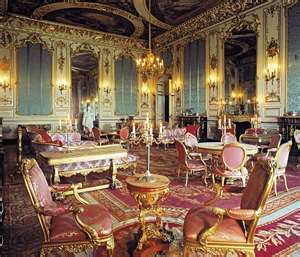
Interior, Belvoir Castle
— The Duke of Wellington after celebrating the birth-day of his old friend, the Earl of Westmoreland at Apthorpe, will join the festivity at Belvoir Castle on Monday, where the natal day of the Duke of Rutland will be commemorated with distinguished honours by a large tenantry, in addition to the visitors from London.— The Right Hon. J. C. Herries left town yesterday for Hardwick to attend his Election. Lord Granville Somerset, Sir Henry Hardinge, and Mr Ross, have also left town to attend their Elections.— Lord Rosslyn has removed from Chapel street to a house in Grosvenor place.— Lord Haddington is expected to leave town this day for Ireland, to enter on the responsible duties of his high office as Lord Lieutenant. Sir Henry Hardinge, Secretary for Ireland, is not expected to go to Ireland till after his Election.— The Brazilian Minister will leave town in the course of a few days for Lisbon, to pay a complimentary visit to the Queen of Portugal on her recent marriage.— The Commissioners for the Reduction of the National Debt held a Meeting yesterday at the Treasury. Sir Robert Feel was present, as Chancellor of the Exchequer. The Governor and Deputy-Governor of the Bank also attended.— The Marquess and Marchioness of Wellesley, since his Lordship's return from the Government of Ireland, have been staying at the Clarendon, where they will remain until they can procure a town residence. The Marchioness will, in a few days, resume her duties at the Court at Brighton, as one of the Ladies in Waiting on the Queen.— The Earl of Eldon has been for some time on a visit to his venerable brother, Lord Stowell, at his seat, Early Court, in Berkshire. The mansion of the Noble Earl, in Hamilton place, Piccadilly, has been recently adorned and beautified, preparatory to his Lordship's return, which is expected in a few days. Lord Stowell's health and strength, we regret to state, continue to decline.
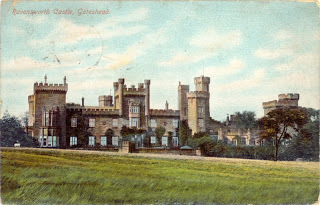
Ravensworth Castle
— The Countess of Mulgrave has been paying a lengthened visit to her father, at Ravensworth Castle, in the county of Durham. From thence she returned to join Lord Mulgrave at the Clajrendon Hotel, in Bond street. The Earl and Countess are now at Brighton, where, with their family, they will remain for a short period.— The Right Hon. Henry Ellis is preparing to leave England on a special mission to Persia. His suite will include Mr Sheridan, as private Secretary, brother of the accomplished Mrs Norton, and son of the late Mr Thomas Sheridan.— The Dowager Marchioness of Salisbury recently gave a magnificent banquet at her house, in Arlington street, to more than twenty distinguished personages, among whom were the Duke of Wellington, Lord and Lady Maryborough, Lord Cowley, the Earl and Countess of Jersey, and Sir John and Lady Anne Beckett. The Dowager Marchioness is now at Hatfield participating the festivities of Christmas, which are annually sustained there by the Marquess and Marchioness of Salisbury, in great splendour.— The Marquess of Hertford and his numerous suite intend to return to London, from Naples, early in the spring. It is reported that a high diplomatic situation has been offered to the Noble Marquess by his friend Sir Robert Peel.
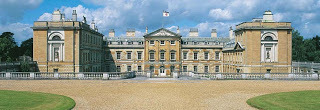
Woburn Abbey
— The festivities at Woburn Abbey have been splendidly sustained during the Christmas holidays. The Duchess of Bedford, the presiding star, has congregated around her all the leading nobility of the county of Bedford, in addition to her numerous relations, including Lady Gcorgiana Russell, and the Marquess and Marchioness of Tavistock and their children.— The Earl and Countess of Albemarle are returned to the Stud House, at Hampton Court, from Paris, where those distinguished persons were called, in consequence of the death of their near relation, Sir William Keppcl, who has left the bulk of his fortune to the Noble Earl. It is doubtful if the Duke of Dorset, the successor of Lord Albemarle as Master of the Horse, will remove to the Stud House, notwithstanding it has for some years been the official residence.— The Earl Fitzwilliam and his delightful family have left Wentworth House, in Yorkshire, for another of his Lordship's seats, Milton, in Northamptonshire, where they intend to remain until the meeting of Parliament.— The Duke of Rutland is now at Belvoir Castle superintending preparations for a grand banquet, to be given at that princely residence, on Monday, in honour of the Noble Duke's birth-day. The Earl and Countess of Lonsdale are expected there from Cottesmore, and the Marquess and Marchioness of Exeter from Burleigh. The Duke of Wellington will likewise be present. Lord Forester, Sir F. Trench, General Upton, and the Hon. William Howard, are already arrived at the Castle. There will be a splendid ball and supper in the evening, to which all the rank and fashion of the county of Rutland are invited.— Hatfield House festivities were this year deprived of the presence of the Duke of Wellington in consequence of various important engagements at the Foreign Office. The Earl of Aberdeen, Lord Rosslyn, the Dowager Marchioness of Salisbury, and many distinguished foreigners, constituted a portion of the noble guests that were invited.— The "Princely Palace" of Alnwick Castle greeted the return of the Duke of Northumberland from the South, who was accompanied by his only brother, Lord Prudhoe, with warm and affectionate rejoicing. The amiable Duchess and her distinguished visitors have been sustaining "old English hospitality" in a style worthy the House of Percy, and commensurate with the large and princely fortune of its noble owner. The Duke and Duchess of Northumberland are expected in London, about the period that the Duchess of Kent and the Princess Victoria return from St Leonard's.— The Marquess and Marchioness of Londonderry and family are passing the Christmas holidays, at Stockton-on-Tees, with much festivity. The noble Marquess is expected in town early next month, preparatory to making arrangements for his departure for St Petersburgh, as Ambassador to the Russian Court.
Court and Fashionable Life
The Duke of Cumberland is expected in town in a few days, from his residence near Berlin. The statement that some of the luggage, and of the domestic establishment, of his Royal Highness arrived in town on Wednesday is incorrect.

Interior, Belvoir Castle
— The Duke of Wellington after celebrating the birth-day of his old friend, the Earl of Westmoreland at Apthorpe, will join the festivity at Belvoir Castle on Monday, where the natal day of the Duke of Rutland will be commemorated with distinguished honours by a large tenantry, in addition to the visitors from London.— The Right Hon. J. C. Herries left town yesterday for Hardwick to attend his Election. Lord Granville Somerset, Sir Henry Hardinge, and Mr Ross, have also left town to attend their Elections.— Lord Rosslyn has removed from Chapel street to a house in Grosvenor place.— Lord Haddington is expected to leave town this day for Ireland, to enter on the responsible duties of his high office as Lord Lieutenant. Sir Henry Hardinge, Secretary for Ireland, is not expected to go to Ireland till after his Election.— The Brazilian Minister will leave town in the course of a few days for Lisbon, to pay a complimentary visit to the Queen of Portugal on her recent marriage.— The Commissioners for the Reduction of the National Debt held a Meeting yesterday at the Treasury. Sir Robert Feel was present, as Chancellor of the Exchequer. The Governor and Deputy-Governor of the Bank also attended.— The Marquess and Marchioness of Wellesley, since his Lordship's return from the Government of Ireland, have been staying at the Clarendon, where they will remain until they can procure a town residence. The Marchioness will, in a few days, resume her duties at the Court at Brighton, as one of the Ladies in Waiting on the Queen.— The Earl of Eldon has been for some time on a visit to his venerable brother, Lord Stowell, at his seat, Early Court, in Berkshire. The mansion of the Noble Earl, in Hamilton place, Piccadilly, has been recently adorned and beautified, preparatory to his Lordship's return, which is expected in a few days. Lord Stowell's health and strength, we regret to state, continue to decline.

Ravensworth Castle
— The Countess of Mulgrave has been paying a lengthened visit to her father, at Ravensworth Castle, in the county of Durham. From thence she returned to join Lord Mulgrave at the Clajrendon Hotel, in Bond street. The Earl and Countess are now at Brighton, where, with their family, they will remain for a short period.— The Right Hon. Henry Ellis is preparing to leave England on a special mission to Persia. His suite will include Mr Sheridan, as private Secretary, brother of the accomplished Mrs Norton, and son of the late Mr Thomas Sheridan.— The Dowager Marchioness of Salisbury recently gave a magnificent banquet at her house, in Arlington street, to more than twenty distinguished personages, among whom were the Duke of Wellington, Lord and Lady Maryborough, Lord Cowley, the Earl and Countess of Jersey, and Sir John and Lady Anne Beckett. The Dowager Marchioness is now at Hatfield participating the festivities of Christmas, which are annually sustained there by the Marquess and Marchioness of Salisbury, in great splendour.— The Marquess of Hertford and his numerous suite intend to return to London, from Naples, early in the spring. It is reported that a high diplomatic situation has been offered to the Noble Marquess by his friend Sir Robert Peel.

Woburn Abbey
— The festivities at Woburn Abbey have been splendidly sustained during the Christmas holidays. The Duchess of Bedford, the presiding star, has congregated around her all the leading nobility of the county of Bedford, in addition to her numerous relations, including Lady Gcorgiana Russell, and the Marquess and Marchioness of Tavistock and their children.— The Earl and Countess of Albemarle are returned to the Stud House, at Hampton Court, from Paris, where those distinguished persons were called, in consequence of the death of their near relation, Sir William Keppcl, who has left the bulk of his fortune to the Noble Earl. It is doubtful if the Duke of Dorset, the successor of Lord Albemarle as Master of the Horse, will remove to the Stud House, notwithstanding it has for some years been the official residence.— The Earl Fitzwilliam and his delightful family have left Wentworth House, in Yorkshire, for another of his Lordship's seats, Milton, in Northamptonshire, where they intend to remain until the meeting of Parliament.— The Duke of Rutland is now at Belvoir Castle superintending preparations for a grand banquet, to be given at that princely residence, on Monday, in honour of the Noble Duke's birth-day. The Earl and Countess of Lonsdale are expected there from Cottesmore, and the Marquess and Marchioness of Exeter from Burleigh. The Duke of Wellington will likewise be present. Lord Forester, Sir F. Trench, General Upton, and the Hon. William Howard, are already arrived at the Castle. There will be a splendid ball and supper in the evening, to which all the rank and fashion of the county of Rutland are invited.— Hatfield House festivities were this year deprived of the presence of the Duke of Wellington in consequence of various important engagements at the Foreign Office. The Earl of Aberdeen, Lord Rosslyn, the Dowager Marchioness of Salisbury, and many distinguished foreigners, constituted a portion of the noble guests that were invited.— The "Princely Palace" of Alnwick Castle greeted the return of the Duke of Northumberland from the South, who was accompanied by his only brother, Lord Prudhoe, with warm and affectionate rejoicing. The amiable Duchess and her distinguished visitors have been sustaining "old English hospitality" in a style worthy the House of Percy, and commensurate with the large and princely fortune of its noble owner. The Duke and Duchess of Northumberland are expected in London, about the period that the Duchess of Kent and the Princess Victoria return from St Leonard's.— The Marquess and Marchioness of Londonderry and family are passing the Christmas holidays, at Stockton-on-Tees, with much festivity. The noble Marquess is expected in town early next month, preparatory to making arrangements for his departure for St Petersburgh, as Ambassador to the Russian Court.
Published on April 17, 2012 00:48
April 15, 2012
Walking Around London
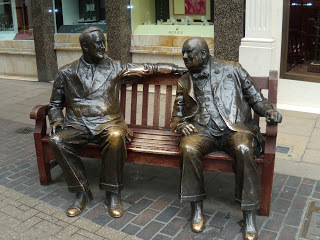 Roosevelt and Churchill on Bond Street, since 1995
Roosevelt and Churchill on Bond Street, since 1995Victoria here, trying to sort out pictures from my last few trips to London, in an attempt not to feel too sorry for myself because I am not crossing the pond this spring. I found a few shots I thought I'd share, as I don't think I have posted them before. The sculpture above is frequently photographed with tourists perched on the knees of the men. The bronze figures of U.S. President Franklin D. Roosevelt and Prime Minister Winston S. Churchill were sculpted by Lawrence Holofcener. They are located where Old Bond Street becomes New Bond Street in Mayfair.
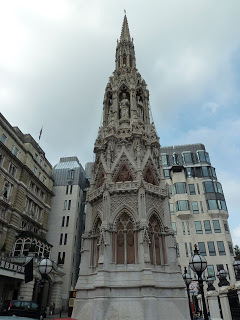 Charing Cross
Charing CrossThis Victorian recreation of the Eleanor Cross was erected in 1865 near the location of the original placed there by King Edward I in the 13th century. It was one of twelve crosses which marked the resting places of the body of his wife, Eleanor of Castile, who died in 1290. She was carried to London for burial in Westminster Abbey over a nearly-two-week period. The Charing Cross stands in front of the railway station of the same name, just off Trafalgar Square. The original position of the Eleanor Cross is now marked by an equestrian statue of King Charles I looking down Whitehall past the site of his beheading.
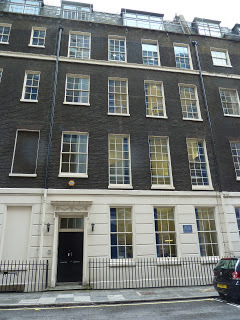
Not far away is this house, built by Robert Adam, and lived in by several prominent Londoners. Its address is 1-3 Robert Street, in part of the Adam Brothers' development of Adelphi Terrace.
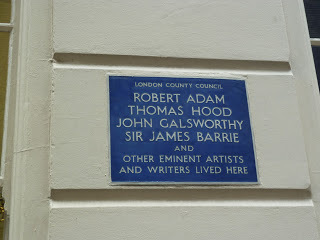
Nearby and also part of the same neighborhood is the home of the RSA, Usually called the Royal Society of Arts. There website is here. The building, designed by the Adams, is classically beautiful.
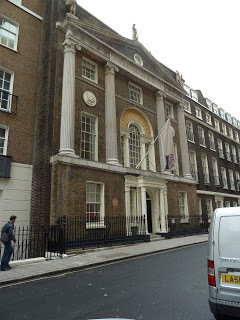
Below is the plaque placed on the building. The RSA is still an active part of British intellectual and scientific life with more than 27,000 fellows and frequent programs, many open to the public. Various other societies, such as the Royal Academy of Arts, is an 18th century spin-off (or whatever they called them in those days).
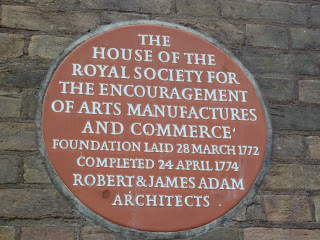
I had not explored this area of London before, between The Strand and the River, sort of between Charing Cross station and the Savoy Hotel. The Adams Brothers built a number of buildings here, culminating in their Adelphi Terrace, an ambitious plan for numerous terrace houses above wharves along the Thames. For various reasons, the development never reached full success and in the 1930's most of it was demolished to build a large gray (and rather grim) semi-Art Deco building for offices, etc. now known as the New Adelphi Building. A good account, accompanied by a map of the district, can be found here. The drawing below shows what the Adelphi Terrace looked like in its heyday.
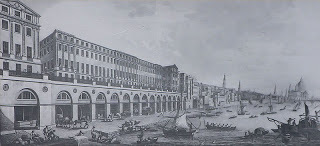
Returning to walk down the Strand, I often stopped near my hotel (The Strand Palace, nicely refurbished) for refreshment at The Wellington, named after our Favorite Duke. Located at 351 The Strand, it is a popular spot for drinks, dinner, and post-theatre entertainment.
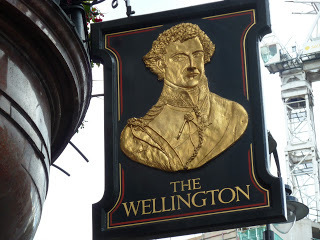
Continuing eastward I came to Somerset House, a building with an interesting history and a continuing role in contemporary London. In the courtyard below was an installation by the celebrated Chinese Artist Ai Weiwei, who was threatened with imprisonment in his home country for his dissident activities. Hard to distinguish in the pictures is Circle of Animals/Zodiac Heads which has also been shown in New York City. The installation recreates 18th century figures near Beijing which were damaged by the British and French during the Opium Wars. Ai's message accompanies the artwork: "Without freedom of speech there is no modern world, just a barbaric one."
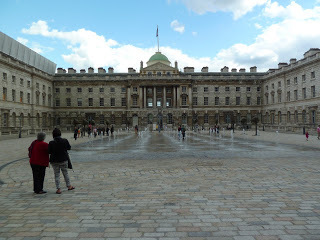 Somerset House
Somerset HouseThe present Somerset House was begun in 1776 to designs by architect Sir William Chambers in a neo-classic style. Originally on the bank of the Thames, it was altered and expanded in the Victorian era with the construction of the embankment and several new wings.In the 16th century, the north bank of the Thames was lined with the mansions of nobles, and on this site a great house had been constructed for Edward Seymour (c. 1500-1552), 1st Duke of Somerset, the Lord Protector during the reign of Edward VI (1537-1553). As uncle of Edward VII (Somerset was brother of Jane Seymour ([.1508-1537]), Somerset tried to impose his will upon an unruly group of courtiers fighting over the spoils of the kingdom after Henry VIII died in 1547. Edmund Seymour ended up on the losing side of court intrigues and lost his head. Somerset House, his mansion, was used to house several queens during the Stuart period, being remodeled over and over again.Acknowledging the need for a fine public building in London, on the continental model, the government of George III had the old buildings demolished for the huge new structure to house government agencies and offices, learned societies, and parts of the Admiralty; before the river bank was altered in the 19th century, large arched watergates allowed barges and small vessels direct access from the river.Damage from WWII was repaired in the 1950’s, and various restorations and remodeling continue to the present. For 150 years, until about 2005, the Registrar General of Births, Death, and Marriages in Somerset House was the place one had to go to obtain these records for England and Wales. Also familiar to UK residents might have been the Inland Revenue offices, from 1849 to 2009, now moved to Bush House.
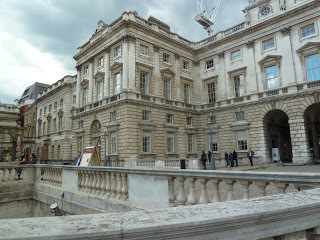 Entrance to the Courtauld Gallery, Somerset House
Entrance to the Courtauld Gallery, Somerset House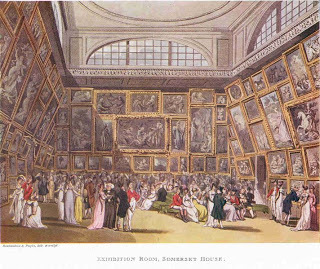 The Exhibition Room at Somerset House by Thomas Rowlandson and Augustus Charles Pugin (1800). This room is now part of the Courtauld Gallery.
The Exhibition Room at Somerset House by Thomas Rowlandson and Augustus Charles Pugin (1800). This room is now part of the Courtauld Gallery.http://www.courtauld.ac.uk/gallery/about/index.shtml
In the 1990’s, The Courtauld Institute of Art and the Courtauld Gallery moved into the section formerly given to the Royal Academy. The website is here. Their very fine collection, particularly strong in 19th century works, can be viewed today in the same setting as the one in which our ancestors viewed the annual Summer Exhibition.
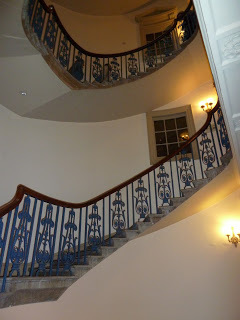
Above is the staircase to the galleries today. You will be glad to hear that a lift will let you avoid climbing up -- or down -- all those steps. Or running into the situation pictured below.
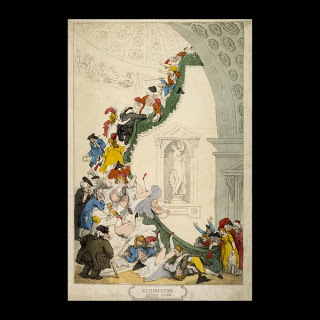 Rowlandson, The Stare Case, The British Museum. The RA and its exhibitions are now located in Burlington House, Piccadilly.
Rowlandson, The Stare Case, The British Museum. The RA and its exhibitions are now located in Burlington House, Piccadilly.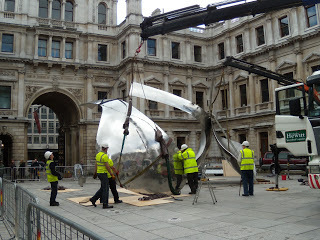
Above, workers install a large sculpture in the courtyard of the Royal Academy in 2009. Below, it is completely assembled.
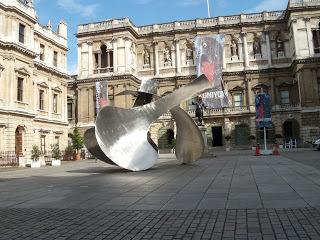 Triton III, by Bryan Kneale, RA, b. 1930
Triton III, by Bryan Kneale, RA, b. 1930Other recent changes at Somerset House include an open terrace for cafes, art installations, concerts, and displays of dancing fountains; in the winter, this area is a public ice rink, where once civil servants parked their cars. Other public areas show the building’s history and the state barge belonging to the Lord Mayor.
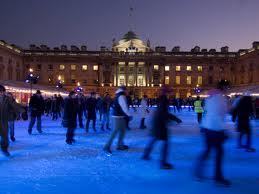
In the view below, the facade of Somerset House is seen on the right and in the distance, the church is St. Mary-le-Strand, which now sits in a traffic island with the street flowing around it.
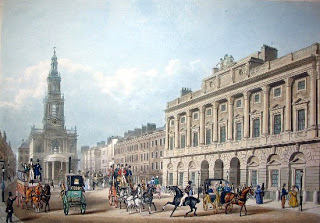
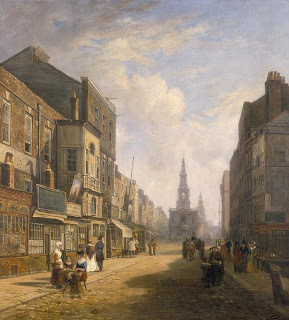 Another period view of The Strand, with St. Mary-le-Strand
Another period view of The Strand, with St. Mary-le-Strand Unfortunately, all my photos of the church appeared to be more of buses, lorries, and autos than the facade, so the one below is borrowed.
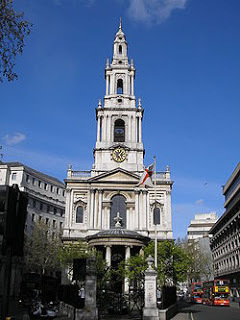
The interior of the church is baroque, reflecting the study trip of the architect James Gibbs (1682-1754) to Italy. Gibbs designed churches (e.g. St. Martin-in-the-Fields), hospital and university buildings (Radcliffe Camera, Oxford) and country houses throughout his career.
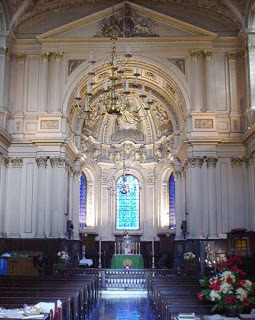
Just east of St. Mary-le-Strand, The Strand becomes Fleet Street, a stretch less known for art museums and churches than press magnates.
Soon, I will share with you some snaps I took while walking around St. James, London.
Published on April 15, 2012 01:00
April 13, 2012
On The Shelf - A Yank Back to England
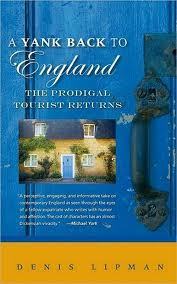
A Yank Back to England: The Prodigal Tourist Returns by Denis Lipman - The cover blurb for this book reads, "Denis Lipman left London’s East End for Washington, DC more than 20 years ago, but made an annual pilgrimage year after year to visit aging parents, a pair of cantankerous, real-life Cockneys. He endured the visits as best he could. Enter an American wife. Not content with a grin-and-bear-it attitude, she declares that since the trip to England was inevitable, then it was to be enjoyed: see things, go places! Against his will, our expat becomes a tourist in his homeland and discovers it’s not so bad after all, certainly better than remembered! Here is a travel memoir more carbolic than bucolic. Discover a place where the sun doesn’t always shine, where going to the loo can be an adventure, and where canned beans on toast is a cornerstone of cuisine. Taste the real East End and tour with a colorful group as they rent cottages, host outrageous relatives, meet the locals and discover the English countryside."
This is a delightful account of Lipman's almost annual trips back to England with his American wife Frances in order to visit his parents, Lew and Jessie. Most visits start at the old family home in Dagenham, an area firmly rooted in London's East End. From here, David and Frances, his parents, and assorted aunts, uncles and cousins take off for parts unknown, usually a rented cottage in a picturesque (and often difficult to find) corner of England. Part memoir and part travelogue, A Yank Back to England tells the sometimes painfully honest tale of tiny tourist villages, seaside resorts, British food and assorted pubs, aging parents, the frailty and strengths of those we love, the reality of childhood memories and the glories of life, love and England.
At the end of A Yank Back to England, you'll be reluctant to close the book. I continue to hope that Lipman will pick up the memoir where he left off. In the meantime, you'll find Denis Lipman's blog here.
Reviews:
“Here is England seen entire, from inside out, from bottom to top, as Denis Lipman returns from America to his working class family home in blighted Dagenham. From there he, his young American wife, and his cockney Mum and Dad embark on a series of funny, touching, madcap and even surreal adventures as they visit celebrated landmarks and holiday spots in England as well as a good many pubs. The result is an absolutely wonderful book, not only about going home again but also about love and family and tradition and the passage of the years.” –Michael Dirda, Pulitzer Prize-winning literary critic (Washington Post) and author of the memoir An Open Book
"A perceptive, engaging and informative take on contemporary England as seen through the eyes of a fellow expatriate who writes with humor and affeciton. The case of characters has an almost Dickensian vivacity." Michael York, actor.
Published on April 13, 2012 00:56
April 11, 2012
The Raglan Collection
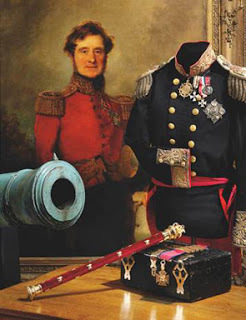
On 4 April 2012, Christie's Auction House in London offered The Raglan Collection: Waterloo, Wellington and The Crimea at the South Kensington saleroom, 85 Old Brompton Road. This private collection from Cefntilla Court, Monmouthshire – the ancestral home of the Barons Raglan since 1855 – included important historical medals, arms and armour, militaria, pictures, furniture, silver, books, Indian weapons and works of art, as well as a selection of enthnographic art. The collection is being sold by order of the Executors of Fitzroy John Somerset, 5th Baron Raglan (great-great-grandson of the 1st Baron Raglan). The collection comprises over 300 lots and was expected to realize in excess of £750,000.
Prior to the sale, Amelia Elborne, Specialist and Head of Sale commented, "FitzRoy Somerset, 1st Baron Raglan, was one of the most well-known British soldiers of the early 19th century. His career spanned service at the right hand of Britain's greatest soldier, the first Duke of Wellington for almost 40 years, during the Peninsular War, at Waterloo, and as Private Secretary, through to his command of British forces in The Crimean War – Raglan's legacy is of foremost importance. This fascinating collection chronicles Lord Raglan's role in some of the most famous battles in British history, as well as featuring more personal items stemming from his relationship with 'the Iron Duke' and the family he created with his wife, Lady Emily Wellesley-Pole, Wellington's favourite niece. The collection comes to auction from Cefntilla Court, the Monmouthshire home which was given by a group of admirers to the son of Lord Raglan after the Field Marshal's death in June 1855 – before what would eventually be victory in The Crimea. The selection on offer has been collected by the 1st Baron Raglan as well as by his descendants – almost all military men themselves – including the 3rd Baron Raglan, a politician and governor of the Isle of Man, and the 4th Baron Raglan, an anthropologist and collector."
Highlights from The CollectionCommissioned into the army at the age of fifteen, Lord FitzRoy Somerset became the Duke of Wellington's Aide-de-camp in 1808, at the age of twenty, as Captain. Somerset proved himself in battle, bearing the dispatches after Talavera (1809) and receiving a wound at Busaco (1810). He played a distinguished role in the bloody storming of Badajoz in 1812 and fought at the battles of Salamanca (1812), Vitoria (1813) and Toulouse (1814), after which he was made KCB. He was awarded the Peninsular Gold Medal (with clasps for Badajoz and Salamanca) illustrated right and the Peninsular Gold Cross (with five clasps) illustrated far right. These latter medals were instituted by the Prince Regent on behalf of his ailing father, George III, to reward senior officers for their service in the Peninsula. For his first battle the recipient would be awarded a gold medal, for his second and third two clasps, and thereafter the exquisite gold cross (with clasps). In total, only 165 crosses and clasps were ever awarded.
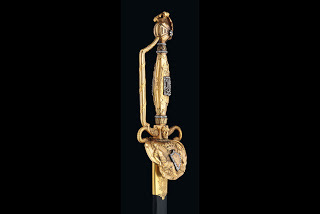 A magnificent gold and diamond-hilted sword presented to General Don Alava by the city of Vitoria in gratitude, who then gave it to his great friend and comrade-in-arms, Lord FitzRoy Somerset. It is believed that Alava holds the distinction of being the only person to have been present at both Trafalgar and Waterloo – one as opposition and the other as an ally to the British. Estimate: £30,000-50,000. Photo: Christie's Images Ltd 2012
A magnificent gold and diamond-hilted sword presented to General Don Alava by the city of Vitoria in gratitude, who then gave it to his great friend and comrade-in-arms, Lord FitzRoy Somerset. It is believed that Alava holds the distinction of being the only person to have been present at both Trafalgar and Waterloo – one as opposition and the other as an ally to the British. Estimate: £30,000-50,000. Photo: Christie's Images Ltd 2012The medals are included in the highly important and exceptionally rare group of honorary awards and medals awarded to Field Marshal Lord Raglan (estimate: £250,000-350,000). The field marshal's baton that Raglan was awarded after his victory at Inkerman in the Crimea (a rank that had been created for Raglan's mentor Wellington after his success at Vitoria) is also included in the lot. Designed by the Prince Regent, and presented by Queen Victoria, the deep red velvet baton is decorated with small gold lions, and the base is engraved: "From Her Majesty Alexandrina Victoria Queen of the United Kingdom of Great Britain and Ireland to Field Marshal The Lord Raglan G.C.B. 1855‟, with maker's mark WN for William Neal, hallmarks for 18 carat gold, London and 1854; it is surmounted by a figure of St. George slaying the dragon. Somerset's Waterloo Medal, issued in 1816-17 and the first award given by the British government to all soldiers present at a battle, as well as his Crimea Medal with four clasps are also included in the lot. The lot comprises a total of twelve awards and medals, and is accompanied by a letter signed by Frederick, Duke of York as commander-in-chief to Lord FitzRoy Somerset, Horse Guards, 21 September 1813.
As Wellington's right-hand-man for almost forty years, the collection includes a number of lots related to the first Duke of Wellington, including a mahogany armchair by Holland and Sons, used by Wellington in his office at Horse Guards (estimate: £4,000-6,000). Somerset married Lady Emily Wellesley-Pole, the daughter of Wellington's brother William Wellesley-Pole later third Earl of Mornington, and Wellington's favourite neice. Wellington gave many personal treasures to Emily, including a diamond-set gold bracelet containing a lock of his hair (estimate: £1,500-2,000), and a heavy Indian gold ring which he had purportedly taken from Tipu Sultan, after the Battle of Seringapatam in 1799 (estimate: £10,000-15,000).
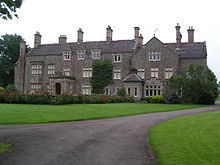
It is the great-grandson of Baron Raglan who is putting the collection up for auction. The collection comes from the family house of Cefntilla Court in Monmouthshire, Wales, which has been the seat of the Barony since 1855. Meanwhile it has emerged that Lord Raglan's heir has put Cefntilla Court (above) on the market at a guide price of £2 million. The chairwoman of a Gwent civic society has called for a "tragic" sale of war memorabilia from the home of Lord Raglan to be stopped. Ms Morse said Usk Civic Society, which Lord Raglan served as president of from 1973 until he died in 2010, was shocked by the sales: "We are pretty sure that he would have wanted it all kept together." She said that the house was given to the son of the first Lord Raglan, FitzRoy Somerset, in recognition of his father's achievements as a soldier and to be with the family for perpetuity.
UPDATE: The Sale has been postponed, with a Christie's spokesperson saying this week: "The auction has been postponed pending resolution of a legal claim filed by a family member." Bettina Harden, of the Raglan Rescue campaign to keep the best parts of the collection together and in this country, said: "The battle may have been won, but now the war begins." The injunction will be reviewed in May. If it is not extended, this allows campaigners only a short time in which to raise the necessary funds. The collection has been valued at £750,000 and the house at £2 million.
We'll bring you updates on the debate as they are received.
Published on April 11, 2012 00:12
April 9, 2012
Centenary of the Titanic Sinking
The White Star ocean liner RMS Titanic sank in the North Atlantic on April 15, 1912, after striking an iceberg. Though the ship had been touted as "unsinkable," more than 1,500 lives were lost in the disaster. Every man, woman and child in the U.S. and U.K. probably knows this story.
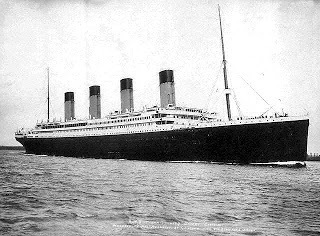
The story has been told and retold in so many formats that it is almost impossible to ignore. And you are no doubt aware of all the re-telling underway for this centennial observance. Soon we will all be watching (or enduring) another Julian Fellowes creation, much hyped after the success of his Downtown Abbey series.
 a photo of an old book just like the one my grandmother owned
a photo of an old book just like the one my grandmother ownedI first learned about the Titanic from a book published in 1912 that I found on Mimi's (my grandmother) bookshelf. She remembered hearing about the disaster as a young married woman and gave the book to me when she eventually moved into a care center. I read every word over and over, studied the pictures and imagined what happened on the doomed ship. Nevertheless, I am an enthusiastic boater, sailor, cruiser and all things aquatic. Who'da thunk it?
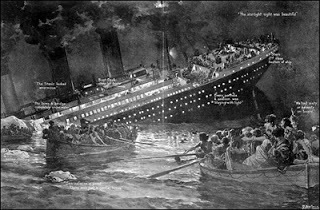
I loved the pictures especially, black and white artists' renderings of the interior of the vessel as well as the lifeboats, the icy waters and the ship slipping below the surface while the orchestra played Nearer My God to Thee. It stirred the heart of a little girl -- and still stirs the heart of a considerably older and more experienced me!
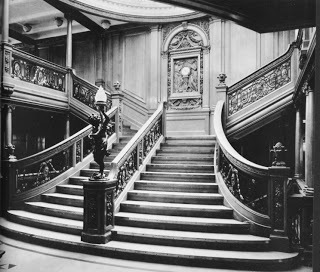 Grand Staircase in First Class
Grand Staircase in First Class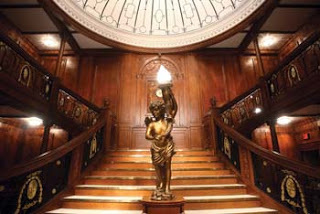 The movie set, 1997
The movie set, 1997Probably all of us remember the movie Titanic, staring Kate Winslet and Leonardo DiCaprio, in 1997. A version in 3-D is in movie theatres now -- or will be soon.
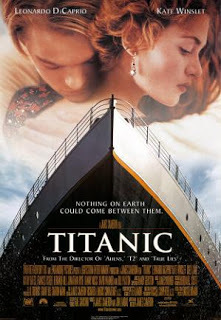
But it did not make anything like the impression on me that the film A Night to Remember (1958) made. I think I lost sleep for weeks. Maybe it had something to do with my age -- then and now!!
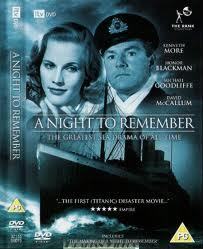
Ceremonies are already underway in Belfast where the ship was built. And there will be many other observances on the anniversary.
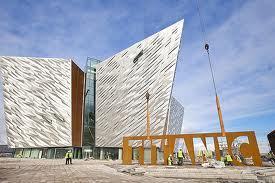 The Memorial in Belfast
The Memorial in BelfastSince soon after the wreck was discovered, exhibitions of materials from the ship have been traveling around the world. I admit to having seen it twice and will probably go again someday. When we entered, they gave us cards with the names of passengers. At the conclusion of the exhibition we learned whether "we" survived or were among the lost. The first time, I survived, but not the second time I visited.
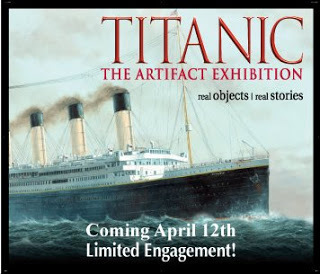
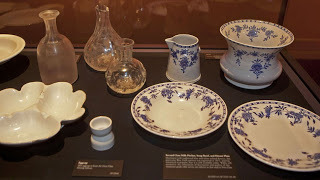 Titanic artifacts
Titanic artifactsOne of the most compelling stories for me as a child was the fate of the skipper, Captain Edward J. Smith, who, in the naval tradition, went down with his ship. He was one of the 1,500+ who died that night; his remains were never recovered.
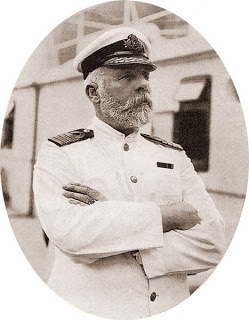 RMS Titanic Captain E. J. Smith
RMS Titanic Captain E. J. SmithI suppose I will not be able to resist watching the new Titanic mini-series when it is shown in the U.S. But given my disappointment with the cliched characters and trite plot of Downton Abbey, I predict similar disappointment -- the early reviews use terms such as "hectic" to describe it.
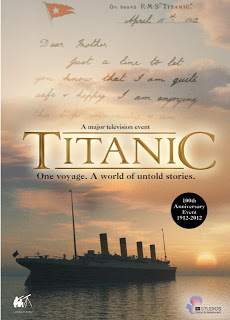
However, I will continue to treasure the vision I have of the doomed ship -- acquired so long ago they are indelible! Many thanks to Mimi for giving me the book!!
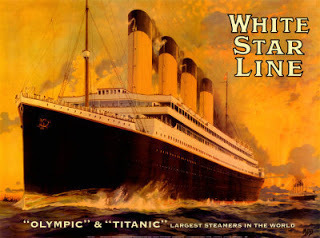
Published on April 09, 2012 01:00
April 7, 2012
Shakespeare's Sisters: Women Writers 1500-1700
At the Folger Shakespeare Library in Washington, D. C., I recently visited a fascinating exhibition entitled Shakespeare's Sisters: Voice of English and European Women Writers, 1500-1700. The exhibition website is here.
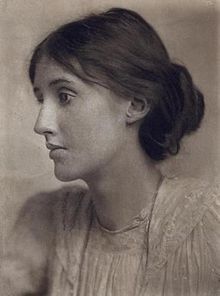
The exhibition began with a famous passage from Virginia Woolf's 1929 volume A Room of One's Own: "(W)hat would have happened had Shakespeare had a wonderfully gifted sister, called Judith, let us say...it needs little skill in psychology to be sure that a highly gifted girl who had tried to use her gift for poetry would have been so thwarted and hindered...that she must have lost her health and sanity."
In Woolf's day, little was known about women who might have written -- and even published -- in Shakespeare's day. But recent scholarship has brought to light a number of such writers and some of their work is shown in this exhibition.
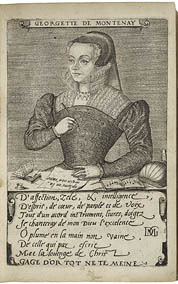 Georgette de Montenay, Emblemes ou devises Chrestiennes, 1619Folger Shakespeare Library Collection
Georgette de Montenay, Emblemes ou devises Chrestiennes, 1619Folger Shakespeare Library Collection
Obviously, due to the age and fragility of the books shown, photographs of them were not allowed, and due to the low light level, my photographs of the text panels are sometimes rather dim. Sorry about that, but I thought you'd rather see them as is than not. Refer to the website for the texts.
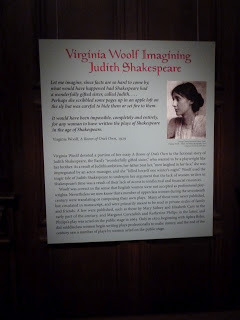
The exhibition is divided into several sections covering such subjects as Religious Writing, Love and Romance, and Families and Salons. Below, a panel celebrating poetry. In the center is Veronica Franco (1546-1591), a Venetian poet and courtesan.
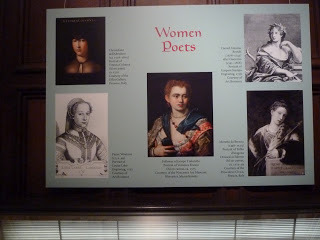
The portrait of Franco is said to be by Tintoretto. A biography, The Honest Courtesan, by Margaret F. Rosenthal, was the basis of a film about Franco's life.
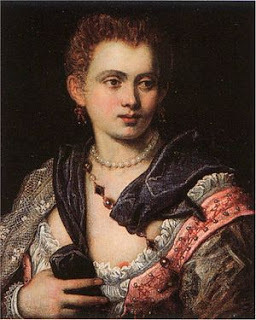
The film, titled in the U.S. Dangerous Beauty (1998) starred Catherine McCormick as Franco, Jacqueline Bisset and Rufus Sewell. I cannot vouch for the accuracy of the film's story, but it does emphasize Franco's writing talents as well as giving sumptuous views of 16th century Venice and its inhabitants.
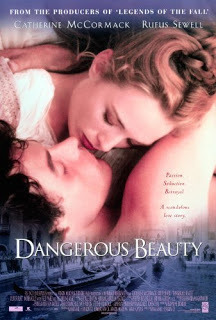
To my knowledge, no one has filmed a life of Lady Anne Clifford, but her life would be good material for a creative screen writer and director.
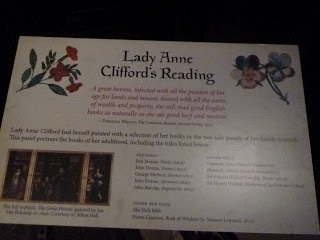
A reproduction of a triptych (attributed to Jan van Belcamp) showing Lady Anne Clifford on either side; in the center panel is Margaret Russell, Countess of Cumberland, and George Clifford, 3rd Earl of Cumberland, with their two sons, is on display.
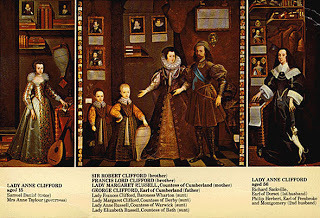
Here is a closer view of Lady Anne Clifford at age sixteen.
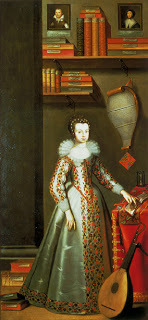
Lady Anne Clifford was raised in the Court of Elizabeth I; she married the Earl of Dorset and later of Pembroke. Not only is she well known for her letters and diaries, she was also a dedicated patron of the arts and literature. She fought for her legal rights to the family estates for almost forty years before she gained success. She was truly a Renaissance woman. Below, Lady Anne at age 56.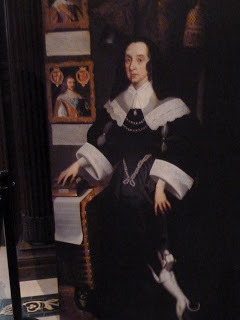
Vita Sackville-West (1892-1962) wrote about Lady Anne in her study of her family and its great estate, Knole and the Sackvilles, published in 1922, and in introducing her works.
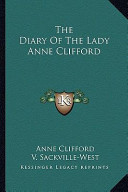
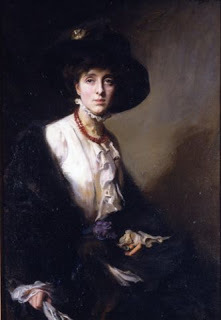 Vita Sackville-West
Vita Sackville-West
Sackville-West, close friend and colleague of Virginia Woolf, also wrote a biography of another of the exhibition's subjects, Aphra Behn (1640-1689). Best known as a playwright, Behn also wrote novels and poetry. Her plays were very popular in the Restoration era theatre in England.
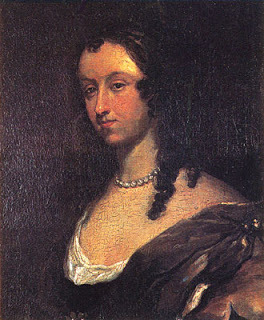 Aphra Behn by Mary Beale
Aphra Behn by Mary Beale
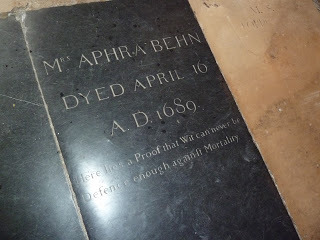 Gravestone of Aphra Behn, in the Cloister of Westminster Abbey, LondonThe inscription: Here lies a Proof that Wit can never be Defense enough against Mortality
Gravestone of Aphra Behn, in the Cloister of Westminster Abbey, LondonThe inscription: Here lies a Proof that Wit can never be Defense enough against Mortality
I recommend spending time on the exhibition's website, Shakespeare's Sisters , for many further insights into this fascinating topic: Voices of English and European Women Writers, 1500-1700.
Below, the Folger Shop.
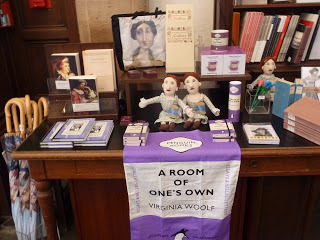
I would be remiss if I did not give the website of the Folger Shop which has wonderful books, catalogues, cards, and assorted items relating to the Woman Writers exhibition as well as to Shakespeare and his era. I highly recommend a visit to the Folger when you come to Washington, D.C. And what's more: admission is free!


The exhibition began with a famous passage from Virginia Woolf's 1929 volume A Room of One's Own: "(W)hat would have happened had Shakespeare had a wonderfully gifted sister, called Judith, let us say...it needs little skill in psychology to be sure that a highly gifted girl who had tried to use her gift for poetry would have been so thwarted and hindered...that she must have lost her health and sanity."
In Woolf's day, little was known about women who might have written -- and even published -- in Shakespeare's day. But recent scholarship has brought to light a number of such writers and some of their work is shown in this exhibition.
 Georgette de Montenay, Emblemes ou devises Chrestiennes, 1619Folger Shakespeare Library Collection
Georgette de Montenay, Emblemes ou devises Chrestiennes, 1619Folger Shakespeare Library CollectionObviously, due to the age and fragility of the books shown, photographs of them were not allowed, and due to the low light level, my photographs of the text panels are sometimes rather dim. Sorry about that, but I thought you'd rather see them as is than not. Refer to the website for the texts.

The exhibition is divided into several sections covering such subjects as Religious Writing, Love and Romance, and Families and Salons. Below, a panel celebrating poetry. In the center is Veronica Franco (1546-1591), a Venetian poet and courtesan.

The portrait of Franco is said to be by Tintoretto. A biography, The Honest Courtesan, by Margaret F. Rosenthal, was the basis of a film about Franco's life.

The film, titled in the U.S. Dangerous Beauty (1998) starred Catherine McCormick as Franco, Jacqueline Bisset and Rufus Sewell. I cannot vouch for the accuracy of the film's story, but it does emphasize Franco's writing talents as well as giving sumptuous views of 16th century Venice and its inhabitants.

To my knowledge, no one has filmed a life of Lady Anne Clifford, but her life would be good material for a creative screen writer and director.

A reproduction of a triptych (attributed to Jan van Belcamp) showing Lady Anne Clifford on either side; in the center panel is Margaret Russell, Countess of Cumberland, and George Clifford, 3rd Earl of Cumberland, with their two sons, is on display.

Here is a closer view of Lady Anne Clifford at age sixteen.

Lady Anne Clifford was raised in the Court of Elizabeth I; she married the Earl of Dorset and later of Pembroke. Not only is she well known for her letters and diaries, she was also a dedicated patron of the arts and literature. She fought for her legal rights to the family estates for almost forty years before she gained success. She was truly a Renaissance woman. Below, Lady Anne at age 56.

Vita Sackville-West (1892-1962) wrote about Lady Anne in her study of her family and its great estate, Knole and the Sackvilles, published in 1922, and in introducing her works.

 Vita Sackville-West
Vita Sackville-WestSackville-West, close friend and colleague of Virginia Woolf, also wrote a biography of another of the exhibition's subjects, Aphra Behn (1640-1689). Best known as a playwright, Behn also wrote novels and poetry. Her plays were very popular in the Restoration era theatre in England.
 Aphra Behn by Mary Beale
Aphra Behn by Mary Beale Gravestone of Aphra Behn, in the Cloister of Westminster Abbey, LondonThe inscription: Here lies a Proof that Wit can never be Defense enough against Mortality
Gravestone of Aphra Behn, in the Cloister of Westminster Abbey, LondonThe inscription: Here lies a Proof that Wit can never be Defense enough against MortalityI recommend spending time on the exhibition's website, Shakespeare's Sisters , for many further insights into this fascinating topic: Voices of English and European Women Writers, 1500-1700.
Below, the Folger Shop.

I would be remiss if I did not give the website of the Folger Shop which has wonderful books, catalogues, cards, and assorted items relating to the Woman Writers exhibition as well as to Shakespeare and his era. I highly recommend a visit to the Folger when you come to Washington, D.C. And what's more: admission is free!
Published on April 07, 2012 01:00
April 5, 2012
The Folger Shakespeare Library
Near the U.S. Capitol and the Library of Congress in Washington, D.C., stands the Folger Library, repository of 82 Shakespeare First Folios -- the largest collection in the world by far of these precious volumes.
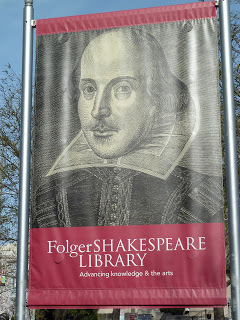
The Folger Library, 201 Capitol St. SE, was the gift to the United States of Henry Clay Folger (1857-1930) and his wife, Emily Jordan Folger (1858-1936). Mr. Folger and his wife were lifelong lovers of Shakespeare and collectors of his works, including First Folios, Quartos, artwork, mementos of performances, and additional material related to the Elizabethan Era and the theatre.
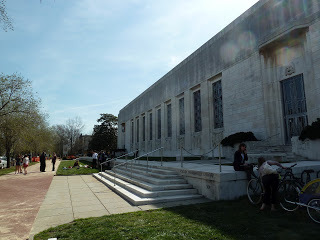
They planned the library as a repository of their collections and as a permanent institution in the U.S. for the scholarly study of Shakespeare and his era and the continuing appreciation of reading and performing his works. Built at a cost of $2 million, the library opened in 1932 with an original endowment of $10 million. The Folger is administered by the Trustees of Amherst College in Massachusetts, alma mater of H. C. Folger.
On the day I visited in March, students were performing snippets of the Bard's plays and having a hilarious time doing so, under the direction of a professional actress in Elizabethan costume, and before an audience of fellow students, parents and teachers.
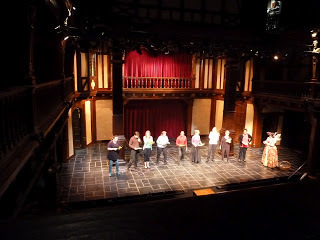
Below, a view of the Folger's theatre, without the gleeful group, but showing all its timbered glory. The theatre is also used for fully staged productions, literary and theatrical awards ceremonies, performances of the Folger Consort, and other activities.
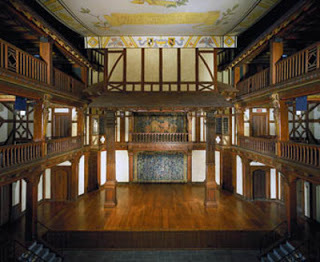 Folger Shakespeare Library, Elizabethan Theatre
Folger Shakespeare Library, Elizabethan Theatre
The Folger presents many special exhibitions. The one I visited, Shakespeare's Sisters, was enlightening. I will blog about it soon.
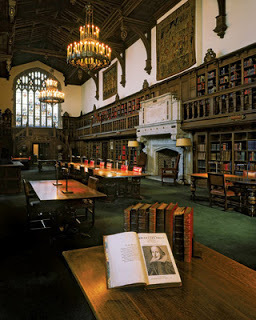
Central to the Folger's mission is scholarship. Imagine how privileged one would be to receive a reader's card and be able to conduct research here in the Reading Room. When I visited, we were allowed only a peek at the premises, which are reserved for serious studies. At the end of the room is the immense window depicting the Seven Ages of Man (from As You Like It).
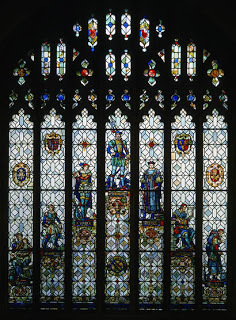
The window, designed especially for the Folger, was executed by the Philadelphia stained glass studio of Nicola D'Ascenzo (1871-1954) in 1932.
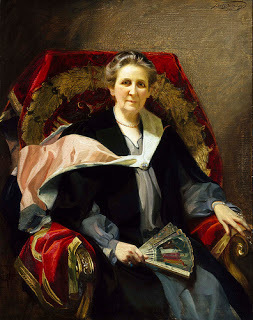 Emily Jordan Folger by Frank O. Salisbury, 1927
Emily Jordan Folger by Frank O. Salisbury, 1927
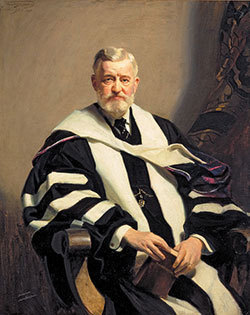 Henry Clay Folger, by Frank O. Salisbury, 1927
Henry Clay Folger, by Frank O. Salisbury, 1927
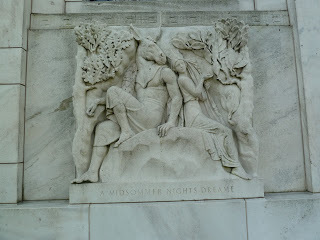
On the exterior of the building, scenes from Shakespeare's favorite plays are captured in white marble bas relief sculptures. Above, a Midsummer Night's Dream. Below, Richard III.
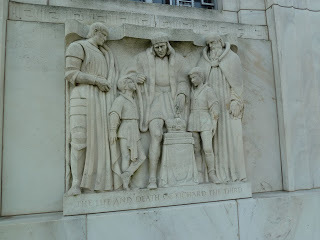
Though the Folger's mission focuses on a writer from hundreds of yeara go and his world, the library's resources and techniques are decidedly up-to-date. Their website (here) is excellent, worth hours of browsing. Many parts of the collection are available digitally, as described here. Hamnet is their free on-line catalogue. The Folger has blogs, facebook pages, and can be found on itunes, youtube and twitter, among other sites. The Conservation Lab is in the forefront of preserving fragile and delicate materials.
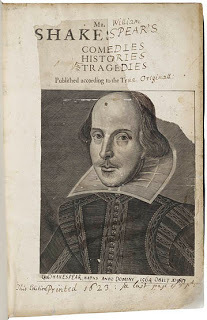 First Folio, Folger Shakespeare Library
First Folio, Folger Shakespeare Library
In 2011, the Folger sponsored an exhibition "Fame, Fortune, and Theft: The Shakespeare First Folio," which told many stories of the creation, acquisition, sales and losses of these precious documents. Since the Folger has the world's largest collection of First Folios (82 at present), it was the perfect venue to explore the topic. First Folios, in case you have forgotten your college Shakespeare facts, are editions of the Bard's plays published in 1623, which contained many plays never before published. In the world today, just over 230 First Folios are known to exist.
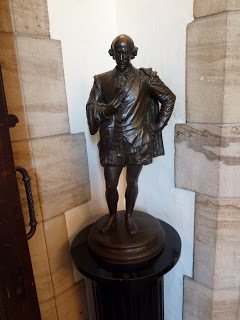 One of many representations of Shakespeare at the Folger
One of many representations of Shakespeare at the Folger
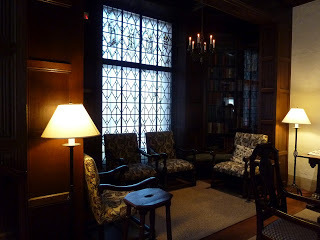 The Founder's Room
The Founder's Room
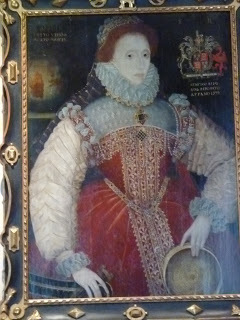 Portrait of Elizabeth I, the "Sieve" portraitby George Gower, 1579in the Folger Collection
Portrait of Elizabeth I, the "Sieve" portraitby George Gower, 1579in the Folger Collection
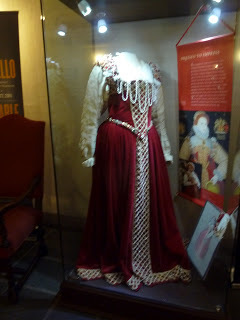
The above costume replicating the Elizabethan gown in the portrait was worn by actress Michael Learned in the 2003 Folger Theatre production of Elizabeth the Queen by Maxwell Adnerson (1888-1959). Ms. Learned required the assistance of a dresser to put on the costume which weighed more than twenty pounds.
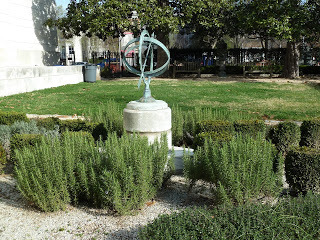 Washington's warm March weather favored growth in the library's Elizabethan Garden
Washington's warm March weather favored growth in the library's Elizabethan Garden
Watch for our report on Shakespeare's Sisters: Voices of English and European Women Writers, 1500-1700, on display at the Folger Shakespeare Library to May 20, 2012


The Folger Library, 201 Capitol St. SE, was the gift to the United States of Henry Clay Folger (1857-1930) and his wife, Emily Jordan Folger (1858-1936). Mr. Folger and his wife were lifelong lovers of Shakespeare and collectors of his works, including First Folios, Quartos, artwork, mementos of performances, and additional material related to the Elizabethan Era and the theatre.

They planned the library as a repository of their collections and as a permanent institution in the U.S. for the scholarly study of Shakespeare and his era and the continuing appreciation of reading and performing his works. Built at a cost of $2 million, the library opened in 1932 with an original endowment of $10 million. The Folger is administered by the Trustees of Amherst College in Massachusetts, alma mater of H. C. Folger.
On the day I visited in March, students were performing snippets of the Bard's plays and having a hilarious time doing so, under the direction of a professional actress in Elizabethan costume, and before an audience of fellow students, parents and teachers.

Below, a view of the Folger's theatre, without the gleeful group, but showing all its timbered glory. The theatre is also used for fully staged productions, literary and theatrical awards ceremonies, performances of the Folger Consort, and other activities.
 Folger Shakespeare Library, Elizabethan Theatre
Folger Shakespeare Library, Elizabethan TheatreThe Folger presents many special exhibitions. The one I visited, Shakespeare's Sisters, was enlightening. I will blog about it soon.

Central to the Folger's mission is scholarship. Imagine how privileged one would be to receive a reader's card and be able to conduct research here in the Reading Room. When I visited, we were allowed only a peek at the premises, which are reserved for serious studies. At the end of the room is the immense window depicting the Seven Ages of Man (from As You Like It).

The window, designed especially for the Folger, was executed by the Philadelphia stained glass studio of Nicola D'Ascenzo (1871-1954) in 1932.
 Emily Jordan Folger by Frank O. Salisbury, 1927
Emily Jordan Folger by Frank O. Salisbury, 1927 Henry Clay Folger, by Frank O. Salisbury, 1927
Henry Clay Folger, by Frank O. Salisbury, 1927
On the exterior of the building, scenes from Shakespeare's favorite plays are captured in white marble bas relief sculptures. Above, a Midsummer Night's Dream. Below, Richard III.

Though the Folger's mission focuses on a writer from hundreds of yeara go and his world, the library's resources and techniques are decidedly up-to-date. Their website (here) is excellent, worth hours of browsing. Many parts of the collection are available digitally, as described here. Hamnet is their free on-line catalogue. The Folger has blogs, facebook pages, and can be found on itunes, youtube and twitter, among other sites. The Conservation Lab is in the forefront of preserving fragile and delicate materials.
 First Folio, Folger Shakespeare Library
First Folio, Folger Shakespeare LibraryIn 2011, the Folger sponsored an exhibition "Fame, Fortune, and Theft: The Shakespeare First Folio," which told many stories of the creation, acquisition, sales and losses of these precious documents. Since the Folger has the world's largest collection of First Folios (82 at present), it was the perfect venue to explore the topic. First Folios, in case you have forgotten your college Shakespeare facts, are editions of the Bard's plays published in 1623, which contained many plays never before published. In the world today, just over 230 First Folios are known to exist.
 One of many representations of Shakespeare at the Folger
One of many representations of Shakespeare at the Folger The Founder's Room
The Founder's Room Portrait of Elizabeth I, the "Sieve" portraitby George Gower, 1579in the Folger Collection
Portrait of Elizabeth I, the "Sieve" portraitby George Gower, 1579in the Folger Collection
The above costume replicating the Elizabethan gown in the portrait was worn by actress Michael Learned in the 2003 Folger Theatre production of Elizabeth the Queen by Maxwell Adnerson (1888-1959). Ms. Learned required the assistance of a dresser to put on the costume which weighed more than twenty pounds.
 Washington's warm March weather favored growth in the library's Elizabethan Garden
Washington's warm March weather favored growth in the library's Elizabethan GardenWatch for our report on Shakespeare's Sisters: Voices of English and European Women Writers, 1500-1700, on display at the Folger Shakespeare Library to May 20, 2012
Published on April 05, 2012 01:00
April 3, 2012
Fab Photos of Queen Elizabeth II at the V and A
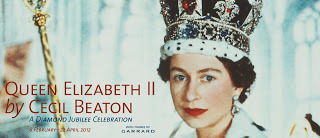
Kristine and Victoria are sad to report that we will miss the V and A Museum's exhibit of Cecil Beaton's photographs of Queen Elizabeth II, which is scheduled to close in London on April 22, 2012. We will share little of it with you today, and here is the website. Below is the schedule for additional presentations of the exhibit in the UK, Canada, and Australia.
Beaton's talents for portrait photography were unrivaled, and he exercised them fully when the subject was the Queen.
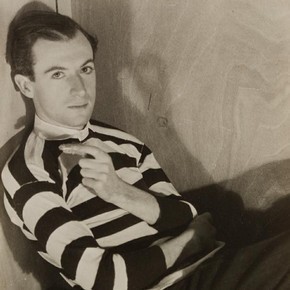 Curtis Moffat, 'Cecil Beaton' about 1925
Curtis Moffat, 'Cecil Beaton' about 1925Gelatin silver print; Museum no. E.1556-2007
Sir Cecil W. H. Beaton (1904-1980) created hundreds of iconic portraits of celebrities ad designed sets and costumes for theatre and film. As a photographer for Vogue magazine, he lived what he saw, and was named to Hall of Fame of the Best Dressed List. Among his best known work
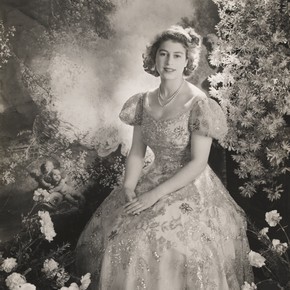 Princess Elizabeth by Cecil Beaton, March 1945 Museum no. PH.1746-1987
Princess Elizabeth by Cecil Beaton, March 1945 Museum no. PH.1746-1987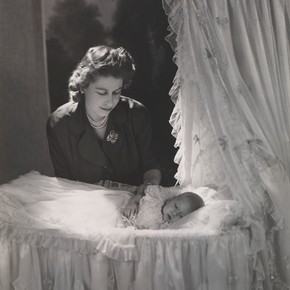 Princess Elizabeth and Prince Charles, Gelatin silver print, December 1948, Buckingham PalaceMuseum no. PH.218-1987
Princess Elizabeth and Prince Charles, Gelatin silver print, December 1948, Buckingham PalaceMuseum no. PH.218-1987Beaton photographed Queen Elizabeth before she came to the throne in 1952, and he took her official Coronation portrait.
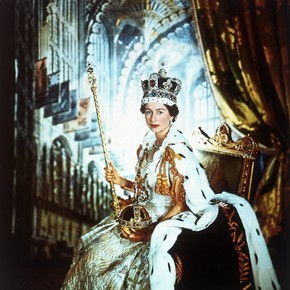 Queen Elizabeth II by Cecil Beaton, 2 June 1953Museum no. PH.311-1987
Queen Elizabeth II by Cecil Beaton, 2 June 1953Museum no. PH.311-1987Beaton was renowned for his romantic portraits of Queen Elizabeth, the Queen Mother.
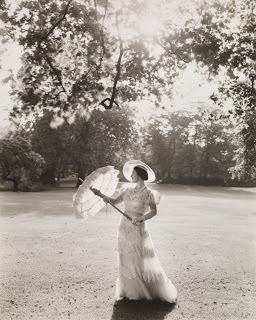 Queen Elizabeth, Buckingham Palace Garden, 1939Gelatin silver print Museum no. E.1374-2010
Queen Elizabeth, Buckingham Palace Garden, 1939Gelatin silver print Museum no. E.1374-2010Queen Elizabeth II by Cecil Beaton tours throughout 2012, the year of the Queen's Diamond Jubilee.United KingdomDundee, McManus Gallery - 30 September 2011 - 8 January 2012
Leeds City Museum - 8 May - 24 June 2012Norwich Castle Museum - 7 July - 30 September 2012Laing Art Gallery, Tyne & Wear - 13 October - 2 December 2012
InternationalFine Art Gallery, Ballarat, Australia - 25 February - 15 April 2012Royal British Columbia Museum, Victoria, British Columbia, Canada - 1 June - 3 September 2012
Perhaps the only compensation for missing this exhibition is that the book Queen Elizabeth II: Portraits by Cecil Beaton by Susanna Brown is available from the V and A Shop, here.
From the book's description: "... This fascinating book explores Beaton's long relationship with the Queen and the royal family, and describes how his royal portraits shaped the monarchy's public image from the 1930s to the late 1960s... [and] moulded the world's perception of a princess, monarch and mother."
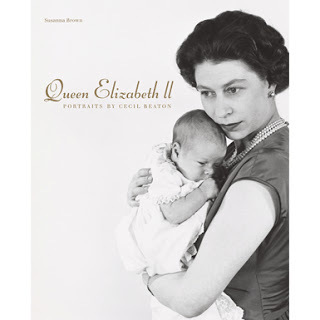
[image error]
Published on April 03, 2012 01:00
April 1, 2012
The Naturalist's Diary for April
From the The Naturalist's Diary of April 1826

The breath of Spring is on thee, Aspley Wood (near Woburn in Bedfordshire).Each shoot of thine is vigorous, from the green,Low-drooping larch, and full unfolded budOf sycamore, and beech, majestic queen!With her tiara on, which crowns the sceneWith beauty,--to the stern oak, on whose rindThe warmest suns and sweetest showers have been,And soft voice of the fond Favonian wind:--His thousand lingering leaves reluctantly unbindBut of all other trees, a clustering crowdBow their young tops rejoicingly to meetThe breeze, which yet not murmurs over-loud,But wastes on Nature's cheek its kisses sweet,To woo her from dark winter;--the wild bleatOf innocent lambs is on the passing gale,Blending with pastoral bells; and at my feet,From yon warm wood the stockdove's plaintive wailWins to the curious ear o'er the subjected vale.
Wiffen's Aonian Hours.
In this picturesque and beautiful description of the poet, the effects of Spring on forest scenery are faithfully delineated, and convey to the mind a vivid representation of the beauties to be observed by those who mark the gradual progress of vegetation. But in Nature, beauty is almost always combined with utility; and while the senses are feasted with the great variety of colours and odours abounding among flowers and plants, the contemplative mind naturally considers the beneficial effects that result from this beautiful combination of vegetable wonders. All is connected (observes M. Mirbel) in the vast system of the globe, and order emanates from the equipoise of conflicting phenomena. Animals carry off the oxygen of the atmosphere, replacing it by carbonic acid gas; and are thus at work to adulterate the air, and render it unfit for respiration. Vegetables take up acid gas, retain the carbon, and give out oxygen; and are thus purifying the air tainted by animals, and re-establishing the necessary proportions between its elements. In Europe, while our vegetables, stripped by the severity of the season of their foliage, no longer yield the air contributing to life, the salutary gas is borne to us by trade winds from the southernmost regions of America. Winds from all quarters of the world intermingle thus the various strata of the atmosphere, and keep its constitution uniform in all seasons, and at all elevations. The substances which are produced by the dissolution of animal and vegetable matter, diluted with water, are absorbed by plants, and constitute a portion of the nourishment by which they are maintained; plants in turn become the food of animals, and these again the prey of others which subsist on flesh. In spite of this perpetual state of war and destruction, nothing perishes, for all is regenerated. Nature has ordained that the two great divisions of organized beings should depend the one upon the other for support, and that both the life and death of individuals should be equally serviceable in keeping up the races of them.

The arrival of the swallow, about the middle of this month, foretells the approach of summer, whose coming, however is too often retarded by the return of Winter in an angry mood, hurling his last hail-storms at the 'proud-pied' and flower-wreathed head of April.
After the swallow, the next bird that appears is the nightingale (Motacilla luscinia) whose praises have been chimed by poets of every clime, and have occupied many a page in this month's Diary of our previous volumes. In our climate, the nightingale seldom sings above six weeks, generally commencing the last week in April.
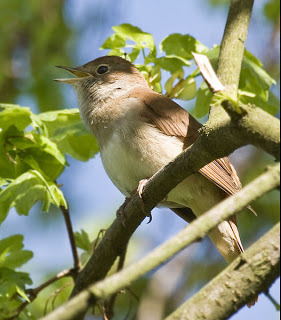 Nightingale
Nightingale
That beautiful bird the wryneck next makes its appearance, preceding the cuckoo by a few days,--whose note that tells of the advancing Spring, and its floral pleasures, is hailed with delight by every lover of Nature.
The other summer birds of passage which arrive this month, make their appearance in the following order: the ring-ousel; the redstart, frequenting old walls and ruinous edifices; the yellow wren, the swift, the white throat, the grasshopper lark, the smallest of the lark kind; and the willow wren, which, as well as house-wren, destroys many pernicious insects. The kite now approaches farmhouses, and villages in search of food and materials for constructing his nest; at other times, unless pinched by hunger, he cautiously avoids man, and all his haunts.
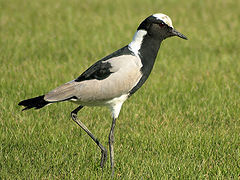 Blacksmith Lapwing
Blacksmith Lapwing
In April, or early in the next month, the lapwing, or pee-wit (Tringa vanellus), lays her eggs, and sits, for she makes no nest. A few pairs will retire to heaths, downs, or ploughed fields during the season of incubation, but the greater portion of them fix their stations upon the banks of the dikes of marshes, or the great drains in our fenny districts. The feathered tribe are now busily engaged in forming their temporary habitations, and in rearing and maintaining their offspring.
The vine expands its empurpled leaves. Honesty, or moonwort, is in flower; and the new sprung leaves of the sweet chestnut, in their turn, are playing in the breeze.
Various kinds of insects are observed in this month; as the jumping spider, seen on garden walls; and the webs of other species of spiders are found on the bushes, palings, outsides of houses. The Iulus terrestris appear, and the death-watch beats early in the month. The wood-ant begins to construct its large conical nest. Little maggots, the first state of young ants, are now to be found in their nests. The shell-snail comes out in troops; and the stinging-fly and the red-ant appear.
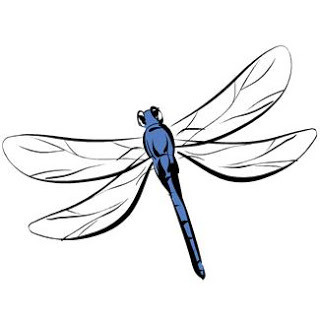
The mole-cricket is the most remarkable of the insect tribe seen about this time. The blue-flesh-fly, and the dragon-fly, are frequently observed towards the end of the month. The great variegated Libellula, which appears, principally, towards the decline of summer, is an animal of singular beauty. The cabbage butterfly, also, now appears. The black slug abounds at this season.
Of the beetle tribe now on the wing, the Scolytus destructor may be noticed for its extraordinary powers of injuring trees. It is described, in Kirby and Spence's Introduction to Entomology, as feeding on the soft inner bark only, and as making its attacks in such vast numbers, that 80,000 have been found on a single tree. The leaves of the trees infested become yellow; the trees themselves die at the top, and soon entirely perish. Their ravages have been long known in Germany, and the insect is formally mentioned in the old liturgies of that country.

The dung of animals swarms at this season with minute Coleoptera; several species of the Lepidoptera will also be found by carefully inspecting garden pales, gates in lanes &c. Many species of bees may be seen sucking the pollen from the sallow which blossoms at this season. Sand and gravel pits should be carefully examined, and under the stones and clods of earth many insects will be discovered."—Samouelle's Introduction to British Entomology, p. 315.
The progress of vegetation is general and rapid in this month. The sloe puts forth its elegant flowers; a host of others follow, among which may be named the ash, ground-ivy, and the box tree. The wild and garden-cherry, the plum, gooseberry and currant trees, the sycamore, the apricot and the nectarine, are in flower:--the garden now is full of
Crimson huesOf the first tint, by April broughtTo the sweet peach-bud.
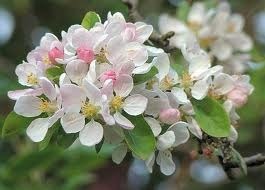 Apple Blossoms
Apple Blossoms
The blossoms of the apple and pear present to the eye a most agreeable spectacle, particularly in those counties which abound with orchards. The almond-tree, whose blush colour blossoms make their appearance before any leaves are seen, is among the earliest of the flowering fruit-trees, and forms a splendid ornament to the shrubbery in the months of March or April.
The beech, the larch, and the elm, are now in full leaf. The larch also exhibits its red tufts or flowers, which soon expand into cones, and the fir tribe show their cones also. Many lovely flowers are showered from the lap of April; among them may be named jonquil, anemone, ranunculus, polyanthus, and the crown-imperial. The double-white, the yellow, and some others of the earlier tulips, are fully opened in this month; but the more illustrious varieties will not blow for some weeks.
The yellow star of Bethlehem in woods; the vernal squill among maritime rocks; and the wood-sorrel, are now in flower. This and the wood anemone have both white blossoms, and inhabit shady woods.

The way-side violet is still seen and loved for its own and for remembrance sake; and the hedge-banks are now studded with primroses the bright yellow of those flowers, beautifully contrasted with the surrounding green of the budding trees, offers a most agreeable spectacle to the lover of Spring scenery. Other flowers which adorn our fields at this time are the checquered daffodil, the lady-smock, the hare-bell, and the cowslip.
 Red-Flowered Cowslip
Red-Flowered Cowslip

The breath of Spring is on thee, Aspley Wood (near Woburn in Bedfordshire).Each shoot of thine is vigorous, from the green,Low-drooping larch, and full unfolded budOf sycamore, and beech, majestic queen!With her tiara on, which crowns the sceneWith beauty,--to the stern oak, on whose rindThe warmest suns and sweetest showers have been,And soft voice of the fond Favonian wind:--His thousand lingering leaves reluctantly unbindBut of all other trees, a clustering crowdBow their young tops rejoicingly to meetThe breeze, which yet not murmurs over-loud,But wastes on Nature's cheek its kisses sweet,To woo her from dark winter;--the wild bleatOf innocent lambs is on the passing gale,Blending with pastoral bells; and at my feet,From yon warm wood the stockdove's plaintive wailWins to the curious ear o'er the subjected vale.
Wiffen's Aonian Hours.
In this picturesque and beautiful description of the poet, the effects of Spring on forest scenery are faithfully delineated, and convey to the mind a vivid representation of the beauties to be observed by those who mark the gradual progress of vegetation. But in Nature, beauty is almost always combined with utility; and while the senses are feasted with the great variety of colours and odours abounding among flowers and plants, the contemplative mind naturally considers the beneficial effects that result from this beautiful combination of vegetable wonders. All is connected (observes M. Mirbel) in the vast system of the globe, and order emanates from the equipoise of conflicting phenomena. Animals carry off the oxygen of the atmosphere, replacing it by carbonic acid gas; and are thus at work to adulterate the air, and render it unfit for respiration. Vegetables take up acid gas, retain the carbon, and give out oxygen; and are thus purifying the air tainted by animals, and re-establishing the necessary proportions between its elements. In Europe, while our vegetables, stripped by the severity of the season of their foliage, no longer yield the air contributing to life, the salutary gas is borne to us by trade winds from the southernmost regions of America. Winds from all quarters of the world intermingle thus the various strata of the atmosphere, and keep its constitution uniform in all seasons, and at all elevations. The substances which are produced by the dissolution of animal and vegetable matter, diluted with water, are absorbed by plants, and constitute a portion of the nourishment by which they are maintained; plants in turn become the food of animals, and these again the prey of others which subsist on flesh. In spite of this perpetual state of war and destruction, nothing perishes, for all is regenerated. Nature has ordained that the two great divisions of organized beings should depend the one upon the other for support, and that both the life and death of individuals should be equally serviceable in keeping up the races of them.

The arrival of the swallow, about the middle of this month, foretells the approach of summer, whose coming, however is too often retarded by the return of Winter in an angry mood, hurling his last hail-storms at the 'proud-pied' and flower-wreathed head of April.
After the swallow, the next bird that appears is the nightingale (Motacilla luscinia) whose praises have been chimed by poets of every clime, and have occupied many a page in this month's Diary of our previous volumes. In our climate, the nightingale seldom sings above six weeks, generally commencing the last week in April.
 Nightingale
NightingaleThat beautiful bird the wryneck next makes its appearance, preceding the cuckoo by a few days,--whose note that tells of the advancing Spring, and its floral pleasures, is hailed with delight by every lover of Nature.
The other summer birds of passage which arrive this month, make their appearance in the following order: the ring-ousel; the redstart, frequenting old walls and ruinous edifices; the yellow wren, the swift, the white throat, the grasshopper lark, the smallest of the lark kind; and the willow wren, which, as well as house-wren, destroys many pernicious insects. The kite now approaches farmhouses, and villages in search of food and materials for constructing his nest; at other times, unless pinched by hunger, he cautiously avoids man, and all his haunts.
 Blacksmith Lapwing
Blacksmith LapwingIn April, or early in the next month, the lapwing, or pee-wit (Tringa vanellus), lays her eggs, and sits, for she makes no nest. A few pairs will retire to heaths, downs, or ploughed fields during the season of incubation, but the greater portion of them fix their stations upon the banks of the dikes of marshes, or the great drains in our fenny districts. The feathered tribe are now busily engaged in forming their temporary habitations, and in rearing and maintaining their offspring.
The vine expands its empurpled leaves. Honesty, or moonwort, is in flower; and the new sprung leaves of the sweet chestnut, in their turn, are playing in the breeze.
Various kinds of insects are observed in this month; as the jumping spider, seen on garden walls; and the webs of other species of spiders are found on the bushes, palings, outsides of houses. The Iulus terrestris appear, and the death-watch beats early in the month. The wood-ant begins to construct its large conical nest. Little maggots, the first state of young ants, are now to be found in their nests. The shell-snail comes out in troops; and the stinging-fly and the red-ant appear.

The mole-cricket is the most remarkable of the insect tribe seen about this time. The blue-flesh-fly, and the dragon-fly, are frequently observed towards the end of the month. The great variegated Libellula, which appears, principally, towards the decline of summer, is an animal of singular beauty. The cabbage butterfly, also, now appears. The black slug abounds at this season.
Of the beetle tribe now on the wing, the Scolytus destructor may be noticed for its extraordinary powers of injuring trees. It is described, in Kirby and Spence's Introduction to Entomology, as feeding on the soft inner bark only, and as making its attacks in such vast numbers, that 80,000 have been found on a single tree. The leaves of the trees infested become yellow; the trees themselves die at the top, and soon entirely perish. Their ravages have been long known in Germany, and the insect is formally mentioned in the old liturgies of that country.

The dung of animals swarms at this season with minute Coleoptera; several species of the Lepidoptera will also be found by carefully inspecting garden pales, gates in lanes &c. Many species of bees may be seen sucking the pollen from the sallow which blossoms at this season. Sand and gravel pits should be carefully examined, and under the stones and clods of earth many insects will be discovered."—Samouelle's Introduction to British Entomology, p. 315.
The progress of vegetation is general and rapid in this month. The sloe puts forth its elegant flowers; a host of others follow, among which may be named the ash, ground-ivy, and the box tree. The wild and garden-cherry, the plum, gooseberry and currant trees, the sycamore, the apricot and the nectarine, are in flower:--the garden now is full of
Crimson huesOf the first tint, by April broughtTo the sweet peach-bud.
 Apple Blossoms
Apple BlossomsThe blossoms of the apple and pear present to the eye a most agreeable spectacle, particularly in those counties which abound with orchards. The almond-tree, whose blush colour blossoms make their appearance before any leaves are seen, is among the earliest of the flowering fruit-trees, and forms a splendid ornament to the shrubbery in the months of March or April.
The beech, the larch, and the elm, are now in full leaf. The larch also exhibits its red tufts or flowers, which soon expand into cones, and the fir tribe show their cones also. Many lovely flowers are showered from the lap of April; among them may be named jonquil, anemone, ranunculus, polyanthus, and the crown-imperial. The double-white, the yellow, and some others of the earlier tulips, are fully opened in this month; but the more illustrious varieties will not blow for some weeks.
The yellow star of Bethlehem in woods; the vernal squill among maritime rocks; and the wood-sorrel, are now in flower. This and the wood anemone have both white blossoms, and inhabit shady woods.

The way-side violet is still seen and loved for its own and for remembrance sake; and the hedge-banks are now studded with primroses the bright yellow of those flowers, beautifully contrasted with the surrounding green of the budding trees, offers a most agreeable spectacle to the lover of Spring scenery. Other flowers which adorn our fields at this time are the checquered daffodil, the lady-smock, the hare-bell, and the cowslip.
 Red-Flowered Cowslip
Red-Flowered Cowslip
Published on April 01, 2012 01:00
March 30, 2012
Obituary of the Duchess of Devonshire
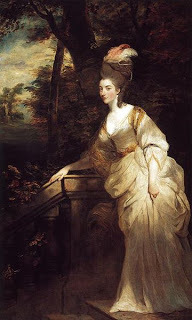 Georgiana by Sir Joshua Reynolds, 1775-6Huntington Art Gallery
Georgiana by Sir Joshua Reynolds, 1775-6Huntington Art GalleryObituary of the Duchess of DevonshireThe Universal Magazine of April 1806
Died at Devonshire house, Piccadilly, aged 49, on the 30th of March, after a short but severe illness, her grace, Georgiana, Duchess of Devonshire. She was eldest daughter of the late Earl Spencer, and Georgiana, his countess, daughter of Stephen Poyntz, Esq. was born June 7, 1757, and married to the present Duke of Devonshire, June 6, 1774. She was educated under the immediate inspection of her venerable mother, the present Countess Dowager Spencer, and indicated even from her infancy the most flattering promises of worth and loveliness, and on her presentation at court, like a comet above the horizon, all inquiries centered in who was to be the happy man destined to receive the fair hand of so much grace and beauty.
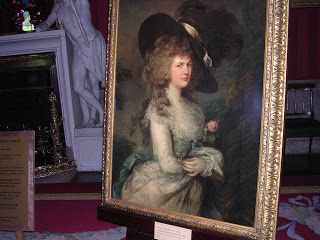 Gainsborough's Georgiana, on display at Chatsworth
Gainsborough's Georgiana, on display at ChatsworthThe young Duke of Devonshire was reserved for the honour and soon after the union of this noble pair, her grace not only became the head, but actually gave, the fashion to every article of female dress, not an apron, gown, cap or bonnet but were Devonshire. So high a station did the duchess retain among the fashionable world, that when the contest with America brought our military into camps, then was her grace found dressed in the uniform of the Derby militia of which the Duke of Devonshire was colonel, and from that time every lady, young or old, became dressed a la militaire. At the first drawing room which the duchess attended after her marriage, she was accompanied by all the distinguished females of the two great families from which she was descended, and to which she was allied. It is asserted that she was literally loaded with jewels, even to produce inconvenience. In the course of the summer of 1792, the Duchess of Devonshire visited the continent, in company with her mother, the Countess Spencer, and her sister Lady Duncannon, both of whom were in declining states of health. During this excursion her grace mixed with the company of several foreign literati, among whom we may enumerate Sausure, Tissot, Lavater, Necker, and the English historian Gibbon; on this occasion public fame attributed to her a short descriptive poem, not void of taste, entitled, the Passage of the Mountain of St Gothard. During the latter part of her life the duchess did not appear in the gay world so much as she had formerly done, yet at the institution of the Pic Nic society in 1801, she stood forward as one of its principal promoters; but the formidable opposition which was organized against these theatrical dilettanti, soon became more than a match for the subscribers to this favourite dramatic project. In the cause of one of the greatest statesmen of the age, (we allude to Mr. Fox) she interested herself frequently and essentially; and in the Westminster election of 1784, her grace took so active a part in favour of that gentleman as subjected her in some degree to the censure of public opinion. The disorder which terminated the life of this distinguished personage, is said to have been an abscess of the liver, the attack of which was first perceived about four months ago, while she sat at table at the Marquis of Stafford's, and which from that period so increased its feverish progress, as eventually resisted all the efforts of the first medical skill. Her mind was richly stored with useful as well as ornamental endowments; she was well read in history, but the Belles Lettres had principally attracted her attention. Though forced into female supremacy by that general admiration which a felicitious combination of charms had excited, she yet found leisure for the systematic exercise of a natural benevolence, which yielding irresistibly and perhaps too indiscriminately, to the supplications of distress, subjected her to embarrassments that the world erroneously imputed to causes less amiable and meritorious. Her grace has left issue, 1. Lady Georgiana Cavendish, born July 12, 1783, married March 21, 1801 to Viscount Morpeth. 2. Lady Henrietta, born August 12, 1785. 3. William George, Marquis of Hartington, born May 21, 1790.
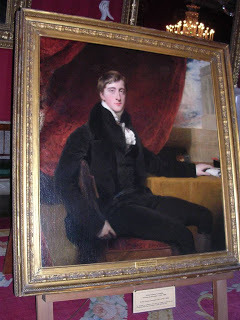 Hart, later the 6th Duke of Devonshire, on display at Chatsworth
Hart, later the 6th Duke of Devonshire, on display at Chatsworth
Published on March 30, 2012 01:00
Kristine Hughes's Blog
- Kristine Hughes's profile
- 6 followers
Kristine Hughes isn't a Goodreads Author
(yet),
but they
do have a blog,
so here are some recent posts imported from
their feed.



